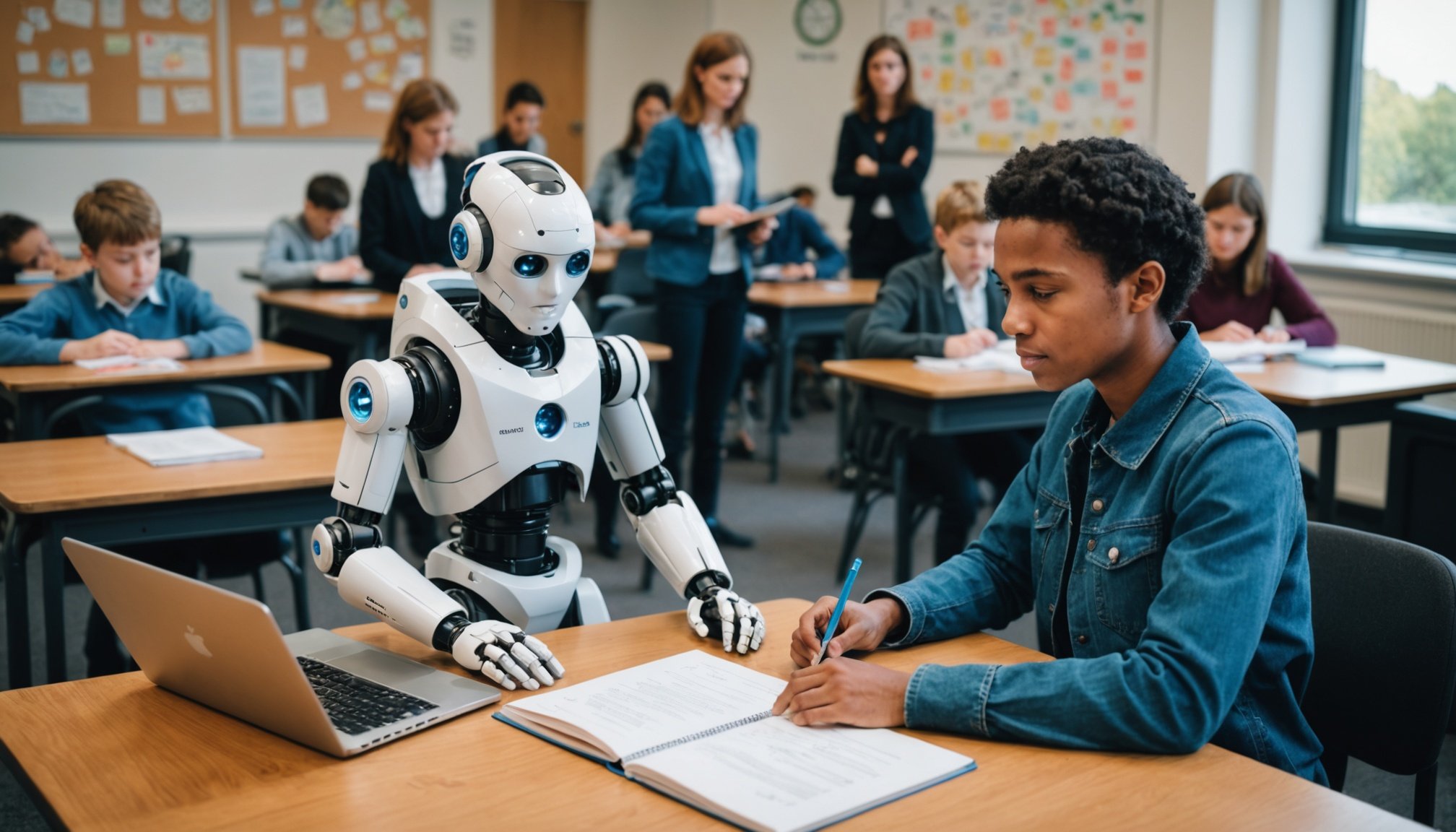Overview of AI Integration in UK Education
Within the evolving landscape of UK education, the incorporation of AI integration has taken centre stage. The educational systems in the UK are progressively embracing AI technologies, reshaping traditional teaching and learning methodologies.
Examination of Current AI Technologies
In the classroom, AI is being utilized to personalizse student learning experiences. This transformation is powered by intelligent tutoring systems and adaptive learning platforms. These systems assess individual student progress, offering tailored content that meets each learner’s unique needs.
Additional reading : Navigating legal landscapes: key regulations for uk businesses embracing drone technology
Moreover, AI-driven predictive analytics are enabling educators to identify struggling students early, allowing for timely interventions. Virtual assistants and chatbots have also been implemented to assist students with common queries, supporting administrative efficiency in educational settings.
Impact of AI on Teaching Methods
AI is not merely altering learning; it is also redefining how educators approach teaching. By automating administrative tasks such as grading and scheduling, teachers have more time to focus on student interaction and enrichment.
Also read : Key considerations for uk tech startups in choosing the perfect co-working space
Government Initiatives
The UK government is actively encouraging AI integration through various initiatives. These include funding for AI research in education and developing strategic plans to increase AI literacy among students and teachers. Such initiatives are critical for positioning UK educational systems at the forefront of technological advancements.
Technological Challenges
The implementation of advanced technologies in education is often met with technological hurdles. One prominent issue is the infrastructure limitations prevalent in many educational institutions.
Insufficient Infrastructure
Schools frequently face infrastructure limitations, hindering the integration of new tech advancements. Outdated hardware and insufficient internet bandwidth prevent effective adoption of modern learning tools. Without the necessary infrastructural foundations, the deployment of sophisticated tech solutions is delayed.
Software Integration Issues
Another challenge lies in software compatibility. Diverse technological systems must interact seamlessly, yet incompatibility can halt progress. When AI platforms are integrated with existing school infrastructure, software compatibility issues often arise, creating barriers in system performance and user experience. Institutions need effective solutions to ensure smooth operation across different platforms.
Data Privacy and Security Concerns
Lastly, with increased technology comes a heightened risk to student data security. The collection and storage of data pose potential threats if robust privacy measures are not in place. Ensuring data privacy is crucial to protect sensitive information from unauthorized access or breaches. To address these technological hurdles, educational institutions must evaluate and upgrade their infrastructures while fostering a reliable, secure tech environment.
Ethical Considerations
Understanding the ethical implications of AI in education is vital to ensure fairness and accountability. Advancing fairness in AI requires addressing algorithm biases which may result in preferential treatment or discrimination. How can AI uphold fairness in educational settings? By critically assessing and validating AI tools, schools can ensure they do not disadvantage any student group.
Bias in AI Algorithms
AI algorithms can inadvertently perpetuate biases present in the training data. Addressing this issue is crucial, as biased outputs can impact educational opportunities for students. Educators should advocate for fairness in AI by monitoring for skewed outcomes and demanding algorithm improvements to minimize bias.
Transparency in AI Decision-Making
Transparency is a cornerstone of ethical AI. All AI processes need to be understandable for educators and students. This means having access to how decisions are made and the criteria used. Why is transparency important? It builds trust and allows accountability by making AI decision-making open for review.
Protecting Student Rights
AI must protect student privacy and rights, ensuring data is used ethically. Awareness and comprehensive policies are needed to protect sensitive information and promote accountability issues. Educators, developers, and policymakers should work together to safeguard these rights while embracing the benefits of AI in education.
Operational Hurdles
Implementing artificial intelligence (AI) in educational settings is not devoid of challenges. Operational barriers can significantly impact the efficiency of AI integration. These hurdles may include inadequate resource allocation, training challenges, and resistance to change.
Resource Limitations
Educational institutions often face resource constraints. Financial restrictions can hamper access to necessary AI technologies or software. Additionally, the allocation of staff to manage and implement AI initiatives can strain existing resources. Schools may encounter funding challenges that limit the scope of AI projects.
Lack of Training for Staff
Another critical operational hurdle is the training challenges staff members face. Many educators lack training in AI, resulting in a skills gap. Professional development and training programs are crucial to equip teachers with the necessary skills to effectively incorporate AI into the classroom. Skill-building and continuous learning opportunities are essential to address this gap.
Resistance to Change
Resistance to change is a prevalent barrier in adopting new technologies. Skepticism towards AI adoption can stem from fear of the unknown or concerns about job replacement. Addressing these concerns involves open dialogue, showcasing AI’s potential benefits, and providing ample support for smooth transition. With careful planning, skepticism can be transformed into acceptance.
Cultural Barriers
When implementing AI in education, cultural attitudes can pose significant challenges. Attitudes towards AI in school often vary widely, influenced by past experiences, trust levels, and perceived impacts on traditional teaching practices. Some communities may exhibit skepticism due to a lack of understanding or fear of technology replacing human roles. This highlights the necessity of addressing cultural barriers in meaningful and respectful ways.
Attitudes Towards AI in School
Understanding different cultural attitudes towards AI involves listening to concerns and providing clear, accessible information about AI’s role and benefits. While some are enthusiastic about AI’s potential, others fear it could undermine personal connections in education. Open dialogues and information sessions can facilitate acceptance by illustrating AI’s potential to enhance learning, not replace it.
Engaging Parents and Communities
Effective stakeholder engagement includes involving parents and communities in discussions about AI. This involves transparency about AI’s educational applications, addressing concerns, and highlighting benefits. Community workshops and informational events can demystify AI, encouraging community involvement and informed opinions.
Collaborations with Educational Stakeholders
Strong partnerships with educational stakeholders, such as local businesses and tech companies, can bridge gaps in resources and knowledge. These collaborations support AI implementation through funding, technological support, and shared expertise. By fostering these partnerships, schools can leverage diverse insights and resources, smoothing the path for AI’s integration into educational environments.
Case Studies of Successful Integration
Examining case studies of successful implementation of AI in education provides valuable insights. These examples highlight the benefits and challenges faced during the integration process.
Example of a UK School Implementing AI
A notable case of successful implementation comes from a UK secondary school that integrated AI to personalise learning experiences. This initiative empowered teachers to tailor educational content to individual student needs, leading to improved engagement and performance. By analysing students’ progress, AI systems recommended targeted interventions, resulting in more effective teaching methods. The school’s experience underscores the importance of having a dedicated team to oversee the process and ensuring transparency with stakeholders.
University-Level AI Integration Success
At a university level, the successful integration of AI was exemplified by a leading UK institution that focused on enhancing administrative efficiency. By automating routine tasks, AI reduced workload and allowed staff to dedicate more time to student support and innovative teaching approaches. This case study highlights that clear objectives and a supportive infrastructure are crucial for AI integration.
Lessons Learned from International Examples
Comparative international case studies reveal best practices, such as Japan’s use of AI in managing enrolment and grading systems, which increased scalability and consistency. These examples stress the significance of cross-departmental collaboration and continued training to overcome challenges. Best practices drawn from international experiences offer a blueprint for implementing AI in education effectively.
Recommendations and Solutions
In today’s rapidly evolving technological landscape, strategic solutions and AI policy frameworks are crucial. Effective policies foster growth while protecting stakeholders.
Developing Comprehensive AI Policies
Adopting AI policy frameworks involves creating broad guidelines addressing the ethical use of AI technologies. These frameworks ensure alignment with educational objectives and societal norms. They necessitate collaboration between policymakers, educators, and technologists to ensure all viewpoints are considered. Key features include privacy protection, equitable access, and instructional integrity.
Creating Support Networks for Educators
Actionable strategies for support networks are vital to empower educators integrating AI into their classrooms. Collaborative networks are essential for exchanging resources and expertise. They support teachers by providing access to training, shared experiences, and best practices, creating a community that encourages continuous learning and adaptation.
Continuous Monitoring and Feedback Mechanisms
For AI tools to remain relevant and effective, establishing continuous monitoring and feedback mechanisms is critical. These systems ensure that AI technologies are regularly assessed and refined. They allow schools to gauge the impact and efficacy of AI tools in real time, fostering an environment of constant improvement. Regular feedback loops help identify challenges early and provide adaptations that support educators and students alike.











